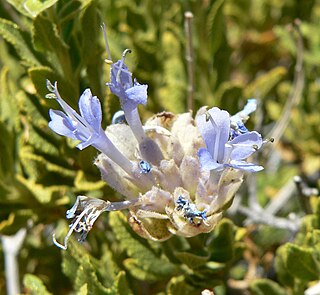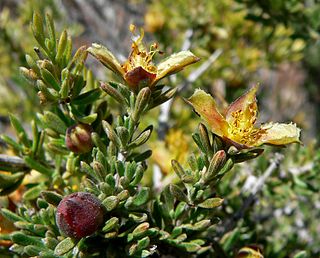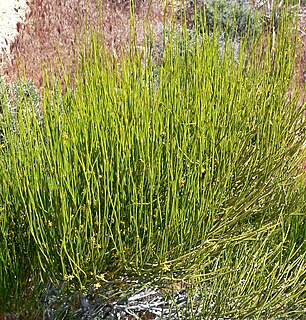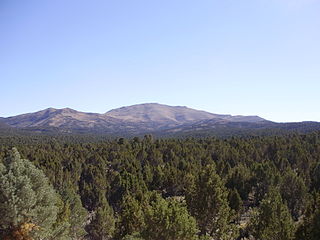Related Research Articles

The ecology of California can be understood by dividing the state into a number of ecoregions, which contain distinct ecological communities of plants and animals in a contiguous region. The ecoregions of California can be grouped into four major groups: desert ecoregions, Mediterranean ecoregions, forested mountains, and coastal forests.

Salvia mohavensis is a species of sage endemic to the Mojave Desert. It is a low rounded shrub growing to 1 m tall with small opposite evergreen leaves 1.5–2 cm long, which are dark green or may appear nearly gray due to a covering of fine white hairs. The 2 cm long flowers are pale blue with protruding stamens, and occur in headlike whorls that occur singly at the tip of the stem. It blooms from April to June.

Delphinium parishii, the desert larkspur, is a flowering plant in the family Ranunculaceae native to the Mojave Desert, in the southwestern United States and northwest Mexico. In Southern California it is also found in the Tehachapi Mountains, Transverse Ranges, and eastern Sierra Nevada.

Coleogyne ramosissima or blackbrush, is a low lying, dark grayish-green, aromatic, spiny, perennial, soft wooded shrub, native to the deserts of the southwestern United States. It is called blackbrush because the gray branches darken when wet by rains. It is in the rose family (Rosaceae), and is the only species in the monotypic genus Coleogyne.

Ephedra californica is a species of Ephedra, known by the common names California jointfir, California ephedra, desert tea, Mormon tea, and cañatillo.

Ephedra viridis, known by the common names green Mormon tea, green ephedra, and Indian tea, is a species of Ephedra. It is indigenous to the Western United States, where it is a member of varied scrub, woodland, desert, and open habitats. It grows at 900–2,300 metres (3,000–7,500 ft) elevations.

Lycium andersonii is a species of flowering plant in the nightshade family, Solanaceae. Its common names include water-jacket, redberry desert-thorn, Anderson thornbush, Anderson's desert thorn, Anderson boxthorn, Anderson lycium, Anderson wolfberry, and squawberry.
The Mesquite Mountains are a mountain range in eastern San Bernardino County, California, near the border with Nevada. They are north of Interstate 15 in California and southeast of Death Valley.

Rafinesquia neomexicana is a species of flowering plant in the family Asteraceae. Common names include desert chicory, plumeseed, or New Mexico plumeseed. It has white showy flowers, milky sap, and weak, zigzag stems, that may grow up through other shrubs for support. It is an annual plant found in dry climate areas of the southwestern deserts of the US and northwestern deserts of Mexico.

Lomatium mohavense is a species of flowering plant in the carrot family known by the common name Mojave desertparsley. It is native to southern California with a few outlying populations in Arizona, Nevada and Baja California. It is found in several types of mountain and desert habitat, including chaparral, woodland, and scrub, mostly from 2,000–7,000 feet (600–2,100 m) elevation.

Oenothera primiveris is a species of flowering plant in the evening primrose family known by the common names yellow desert evening primrose, bottle evening-primrose, and desert evening-primrose.

Pinyon–juniper woodland, also spelled piñon–juniper woodland, is a vegetation type (biome) of Western United States higher elevation deserts, characterized by being an open forest dominated by low, bushy, evergreen junipers, pinyon pines, and their associates which vary from region to region. The woodland's density and crown height varies dramatically depending on the site's soil and climate, the age of the stand, and the particular species present, with mature trees ranging in height from as low as 2 meters up to 15 meters. At lower elevations, junipers often predominate and trees are spaced widely, bordering on and mingling with grassland or shrubland. As elevation increases, pinyon pines become common and trees grow closer, forming denser canopies. Historically, pinyon-juniper woodland has provided a vital source of fuel and food for peoples of the American Southwest.

Cylindropuntia echinocarpa is a species of cactus known by the common names silver cholla, golden cholla, and Wiggins' cholla. It was formerly named Opuntia echinocarpa.

The Clipper Mountain Wilderness is a wilderness area in the Clipper Mountains of the eastern Mojave Desert and within Mojave Trails National Monument, located in northeastern San Bernardino County, California. It is under the jurisdiction of the Bureau of Land Management.

Thamnosma montana, the turpentine broom, or Mojave desert-rue, is a shrub in the citrus family Rutaceae. It is native to the deserts of the southwestern United States and northern Mexico. Except immediately after heavy rains, its straight stems usually lack leaves, giving it a broom-like appearance. The Latin specific epithet montana refers to mountains or coming from mountains.

Tidestromia lanuginosa is a species of flowering plant in the family Amaranthaceae known by the common name woolly tidestromia.

Ambrosia salsola, commonly called cheesebush, winged ragweed, burrobush, white burrobrush, and desert pearl, is a species of perennial shrub in the family Asteraceae native to deserts of the southwestern United States and northwestern Mexico.
Sagebrush scrub is a vegetation type (biome) of mid to high elevation Western United States deserts characterized by low growing, drought resistant shrubs including sagebrush and its associates. It is the dominant vegetation type of the Great Basin Desert, occurs along the margins of the Mojave Desert, including in the southern slopes of the Sierra Nevadas and Transverse Ranges of California, and occurs in the Colorado Plateau and Canyonlands region, where it may be referred to as cool desert shrub.

Hilaria rigida is a species of clumping perennial grass that is widespread in California deserts. It is commonly known as big galleta. It is a monocot in the Hilaria genus of the grass family (Poaceae).
The flora of the Colorado Plateau and Canyonlands region of the Western United States.